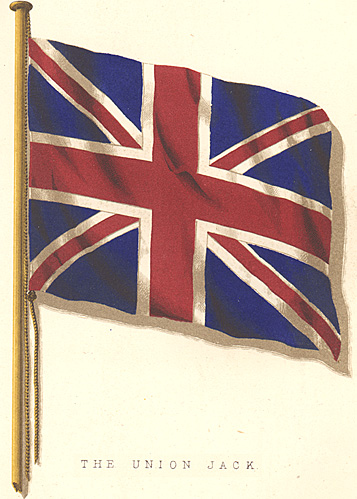 Next to the Royal Standard of England fitly comes the Union Jack -- equally an emblem of her
valour and token of her dominion. From the most remote period of England's history, when her navy was first founded by King Alfred, down to the crowning victory of Copenhagen, which so fully established her in the recognised supremacy of the seas, her flag has been proudly borne in a series of splendid naval achievements -- sometimes, no doubt, yielding to adversity, but never submitting to disgrace.
Next to the Royal Standard of England fitly comes the Union Jack -- equally an emblem of her
valour and token of her dominion. From the most remote period of England's history, when her navy was first founded by King Alfred, down to the crowning victory of Copenhagen, which so fully established her in the recognised supremacy of the seas, her flag has been proudly borne in a series of splendid naval achievements -- sometimes, no doubt, yielding to adversity, but never submitting to disgrace.
Previous to the union of England with Scotland, the Cross of St. George, which is still the distinctive banner of England, was always borne as an ensign by the British navy. It now denotes the admirals of the White Squadron. In 1606, three years after the accession of James the First, that monarch, by a royal ordinance, declared that "the Jack" should be formed by laying the fimbriated red cross of St. George over the white and blue cross of St. Andrew: these being the colours of Scotland.
It is supposed that this union of colours, combined with the signature of "Jaques" to the royal ordinance which decreed it, established the term "Union Jack." This would be a plausible explanation of a very doubtful matter, were it not for the fact that King James the First always signed as follows: "James R."
In 1801 the legislative Union with Ireland took place, and the national standard became once more the subject of Royal proclamation. It was then decreed that the cross of St. Patrick, as the banner of Ireland, should be laid over that of St. Andrew, and that both should be covered by the red cross of St. George; and thus the Union Jack of the present day was formed.
There is an important difference to be observed in the disposition of the bars in the cross of St. Patrick and in the banner of Ireland, which is caused by their being counterchanged. The heraldic description is "Azure, the crosses saltire of St. Andrew and St. Patrick quarterly per saltire, counterchanged argent and gules, the latter fimbriated of the second, surmounted by the cross of St. George, fimbriated as the saltire."
The Union Jack is carried at the main by the Admiral of England as the distinguishing flag of his rank; it is also used as a signal, and displayed upon the bowsprits of all men-of-war, and sometimes borne by regiments of the army, and hoisted on forts, castles, etc. No merchant vessel is, however, allowed to hoist the Jack, unless it is bordered on all sides with white, equal in breadth to one-fifth of the breadth of the Jack itself, exclusive of such border. When thus white-bordered, it is hoisted by both navy and merchant service as a signal for a pilot.
Back to Colors of the British Army: Grenadier Guards Table of Contents
Back to 19th Century: Victorian Era Book List
Back to ME-Books Master Library Desk
Back to MagWeb Master Magazine List
© Copyright 2005 by Coalition Web, Inc.
This article appears in ME-Books (MagWeb.com Military E-Books) on the Internet World Wide Web.
Articles from military history and related magazines are available at http://www.magweb.com